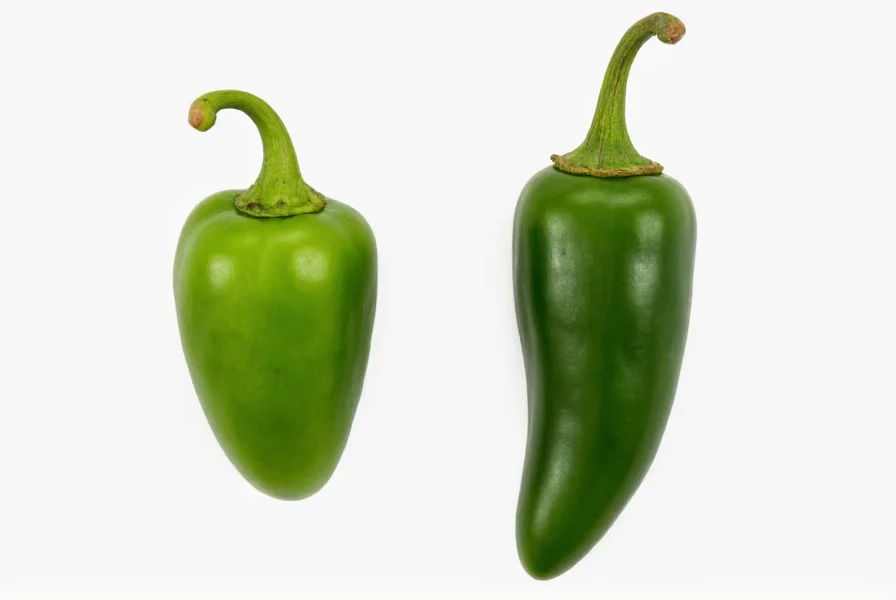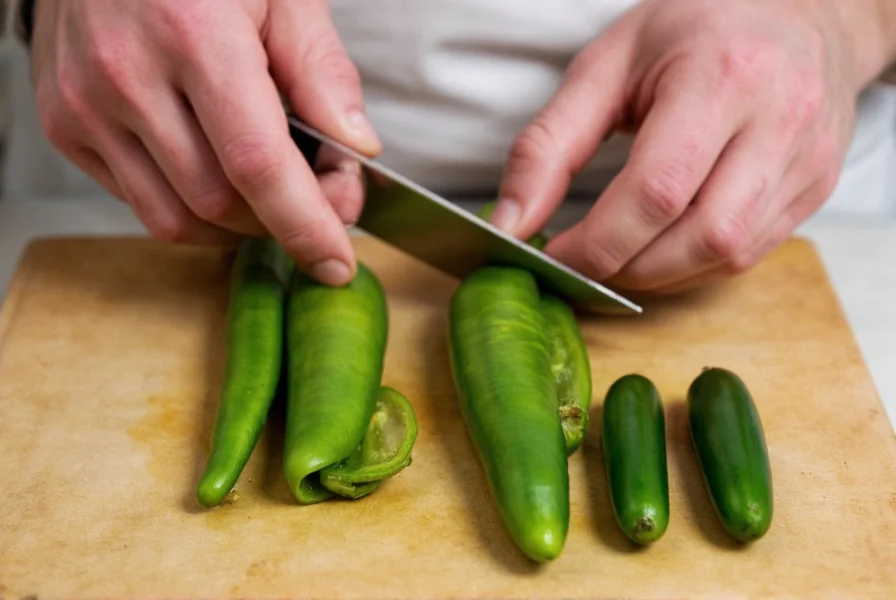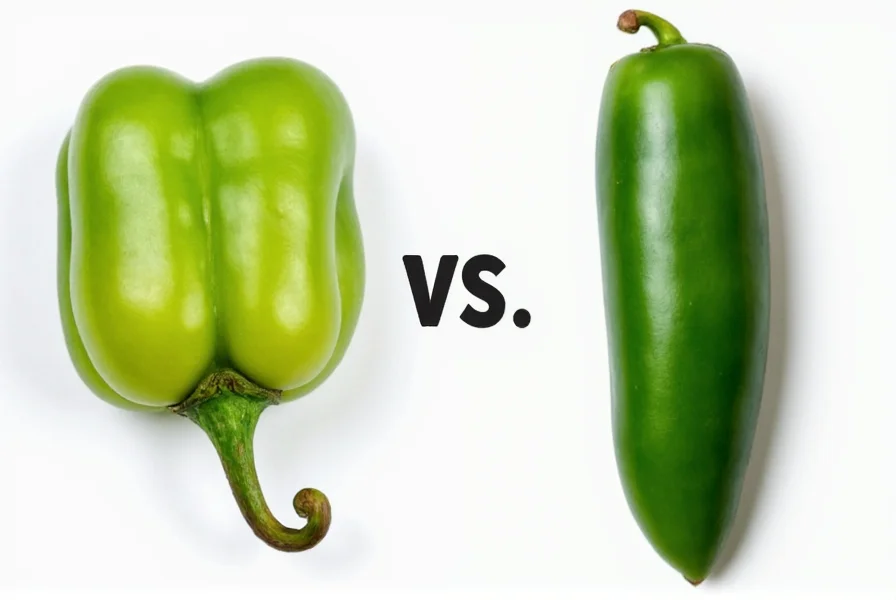Understanding the differences between serrano peppers and jalapeños is essential for home cooks and culinary enthusiasts who want to achieve the perfect balance of heat and flavor in their dishes. While both belong to the Capsicum annuum species and originate from Mexico, these peppers serve distinct purposes in the kitchen due to their unique characteristics. This comprehensive comparison examines every aspect that matters when choosing between serrano pepper vs jalapeño for your cooking needs.
Heat Level: The Fundamental Difference
The most significant distinction between these peppers lies in their heat intensity. Serrano peppers pack considerably more punch, registering between 10,000-23,000 Scoville Heat Units (SHU) on the capsaicin scale. In contrast, jalapeños fall in the 2,500-8,000 SHU range, making them noticeably milder. This means a serrano pepper can be up to nine times hotter than a jalapeño.
When working with serranos, exercise caution as their heat can overwhelm dishes if used in equal quantities to jalapeños. For substitution purposes, use approximately half the amount of serranos when replacing jalapeños in recipes. This knowledge proves invaluable for anyone exploring authentic Mexican cuisine or developing their own hot sauce recipes.
| Pepper Type | Scoville Heat Units | Relative Heat Level | Substitution Ratio |
|---|---|---|---|
| Serrano Pepper | 10,000-23,000 SHU | Very Hot | 1 serrano = 2 jalapeños |
| Jalapeño Pepper | 2,500-8,000 SHU | Moderate | 1 jalapeño = 0.5 serrano |
Physical Characteristics Comparison
Visually distinguishing serrano peppers from jalapeños helps prevent culinary mishaps. Serranos typically measure 1-3 inches in length with a straighter, more cylindrical shape and thinner walls. They grow upright on the plant rather than hanging down. Common colors include bright green when immature, transitioning to red, orange, yellow, or brown when fully ripe.
Jalapeños are larger, usually 2-4 inches long, with a slightly curved shape and noticeably thicker walls. They hang downward from the plant and transition from dark green to bright red as they mature. The thicker walls of jalapeños make them ideal for stuffing applications where serranos would be too fragile.

Flavor Profiles: Beyond the Heat
While heat level often dominates the serrano pepper vs jalapeño discussion, their flavor profiles differ significantly. Serranos deliver a bright, grassy flavor with citrus notes and less sweetness. This clean heat makes them perfect for salsas where you want the pepper flavor to shine through without overwhelming other ingredients.
Jalapeños offer a more complex flavor profile with earthy, slightly sweet, and vegetal notes. Their thicker walls contain more sugars, contributing to their milder perception and making them excellent for roasting or smoking (as chipotles). When comparing fresh serrano vs jalapeño in raw applications, the jalapeño's sweetness balances its heat more effectively.
Culinary Applications and Best Uses
Understanding where each pepper excels helps maximize their potential in your cooking. Serranos shine in applications where intense heat is desired without excessive bulk:
- Traditional Mexican salsas like salsa verde and pico de gallo
- Hot sauces requiring clean, sharp heat
- Garnishes for soups and stews where visual appeal matters
- Finely diced additions to guacamole for extra kick
Jalapeños prove more versatile for various cooking techniques:
- Stuffed jalapeño poppers (their thick walls hold fillings well)
- Pickled jalapeños for sandwiches and nachos
- Smoked into chipotles for deep, smoky flavors
- Raw in salads and sandwiches where milder heat is preferred
- Jalapeño jelly and other sweet-heat preserves
Substitution Guidelines for Home Cooks
When comparing serrano vs jalapeño for substitution purposes, consider these practical guidelines:
Replacing jalapeños with serranos: Use half the amount of serranos to achieve similar heat levels. For example, if a recipe calls for two jalapeños, use one serrano pepper. This adjustment works well in salsas, sauces, and soups where the peppers are finely diced or pureed.
Replacing serranos with jalapeños: You'll need approximately twice as many jalapeños to match serrano heat. However, be mindful that the thicker walls of jalapeños may alter the texture of your dish. This substitution works best in cooked applications rather than fresh preparations.
For those sensitive to heat, consider removing seeds and membranes from both peppers, though serranos maintain more heat in their flesh compared to jalapeños, where most heat concentrates in the seeds and ribs.

Growing Considerations for Gardeners
Home gardeners exploring serrano pepper vs jalapeño cultivation will find notable differences. Serrano plants typically grow 24-36 inches tall with a more compact, upright growth habit. They produce numerous small peppers that grow pointing upward. Serranos generally mature in 70-80 days from transplanting.
Jalapeño plants reach 24-36 inches in height but spread more widely. They produce fewer, larger peppers that hang downward from the branches. Jalapeños typically mature in 70-80 days as well, but their thicker walls make them more resistant to pests and diseases.
Both varieties thrive in similar conditions—full sun, well-draining soil, and consistent moisture—but serranos may require more careful handling during harvest due to their thinner walls and more delicate nature.
Storage and Handling Tips
Proper storage extends the usability of both peppers. Store fresh serranos and jalapeños in the refrigerator's crisper drawer in a paper bag for optimal humidity control. They'll keep for 1-2 weeks this way. For longer storage, freeze whole peppers on a baking sheet before transferring to freezer bags—they'll maintain quality for 6-8 months.
When handling hot peppers, always wear gloves to prevent capsaicin burns on your skin. Never touch your face after handling, and wash hands thoroughly with soap and water afterward. If you experience burning, dairy products like milk or yogurt provide relief better than water.
Conclusion: Choosing the Right Pepper
The serrano pepper vs jalapeño decision ultimately depends on your specific culinary needs. Choose serranos when you want intense heat with bright flavor in salsas and sauces. Opt for jalapeños when you need a more versatile pepper for stuffing, pickling, or dishes requiring milder heat with sweeter notes. Understanding these differences transforms your cooking by ensuring you select the perfect pepper for each application, whether you're making authentic Mexican dishes or experimenting with your own creations.
Frequently Asked Questions
Can I substitute serrano peppers for jalapeños in jalapeño poppers?
While possible, serranos aren't ideal for stuffed poppers due to their thinner walls and significantly higher heat. Jalapeños' thicker walls hold fillings better and provide more manageable heat for this application. If you must use serranos, select larger specimens and use only half the quantity to avoid overwhelming heat.
Which pepper is better for making hot sauce: serrano or jalapeño?
Serranos create hotter, brighter hot sauces with cleaner heat, making them ideal for traditional Mexican-style sauces. Jalapeños produce milder sauces with more vegetal, slightly sweet notes, perfect for beginner-friendly hot sauces. Many hot sauce makers blend both peppers to achieve balanced heat and flavor complexity.
Do serrano peppers get hotter as they change color?
Yes, like jalapeños, serranos increase in heat as they mature and change color from green to red, orange, or yellow. Fully ripe serranos can be up to 50% hotter than their green counterparts. The flavor also becomes fruitier and more complex while maintaining their characteristic bright heat.
Why do some jalapeños have corking or white lines?
Corking—those white, striated lines on jalapeños—indicates the pepper grew rapidly, often developing more capsaicin in the process. Corked jalapeños tend to be hotter than smooth-skinned ones. This natural occurrence doesn't affect safety or quality and is actually prized by hot sauce makers seeking extra heat.











 浙公网安备
33010002000092号
浙公网安备
33010002000092号 浙B2-20120091-4
浙B2-20120091-4